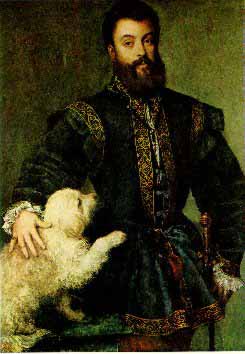|
Bichon in Spain
The Bichon Teneriffe was extremely popular in Spanish courts during the 16th Century, and painters of the Spanish
school often included such dogs in their paintings. Serval can be found in the works of Goya (1746 - 1828). Goya
was both a painter and an etcher and was taken on as a court artist to Charles IV in 1789.
 |
 |
| |
|

The Bichon was especially popular in the 16th Century Spain
among royalty and artist who often depicted the dogs in their works.
|
|
 |
 |
Bichon in France
Under Francis I (1515 - 1547), the Bichon, known as the Bichon Teneriffe, appeared in France and a few decades later
became especially popular. It was in the court of Henry III (1547 - 1589) where this captivating little dog found itself pampered,
to the extreme by wearing ribbons and perfumes. It was recorded that the French Kings and their ladies loved their little
white dogs so much that they carried them in tray like baskets attached around their necks by ribbons whereever they went.
Under Louis XIV who reigned from 1643 - 1715, the small dog was designated as the court " Pet of Choice" reputedly because
it was easy to carry about.
 |
 |
| |
|

During the French Recolution in 1789, the Bichon were far less
prominet, but they re-emerged with Napoleon III, who declared himself emperor in 1852.
|
|
 |
 |
Bichon's Decline
Having been a pampered pet for centuries, towards the close of the 19th century, the Bichon seemed to go out of fashion.
However, some were still found in circuses and fairs, often called "the dog of the street". Their lives were far removed from
the luxury the breed had known in earlier years. Sometimes, they can be found roaming in the streets and were occassional
companions to the blind.
Bichon's Revival
A handful of breeders in France and Belgium decided to create a breeding programme for the Bichon Teneriffe.
or Bichon a Poil Frise after the First World War was behind them. They hoped this would revive the breed and take
it beyond the status of the circus or street dogs. In 1933, enough progress had been made for a breed standard to be drawn
up. This was written by Mme Bouctovagniez, who was the President of the Toy Club of France. However, when the question of
a breed name arose, it was Mme Nizet de Leemans, head of the Federation Cynologique International's Breed Standard Committee
who made named them Bichon Frise, meaning fluffy little dog.
 |
 |
| |
|

It was until October 18, 1934, the Bichon Frise was registered
in the Livre des Origines Francaises. Despite this historical decision, many people continued to use the names Bichon Teneriffe
or Bichon a Poil Frise even in the early 1950s.
|
|
 |
 |
|
 |
 |
|
 |
|
 |
 |
|
| María Teresa de Borbón y Vallabriga - 1783 |

|
|
|
Little María Teresa was the niece of King Carlos III of Spain in
the 16th century. This dog has been identified as a toy griffon in certain texts, but the coloring appears wrong. The depictions
of all these dogs in Goya's paintings strongly suggest Bichon with perhaps some Maltese.
- From the Bichon Frise in Art
Online Exhibition by Edward J. Shephard Jr.
|
|
 |
 |
|
 |
|
 |
 |
|
| Federico Gonzaga, Duke of Mantua 1529 |

|
|
|
Everything about this portrait suggests a true Bichon
- From the Bichon Frise in Art
Online Exhibition by Edward J. Shephard Jr.
|
|
 |
 |
|
 |
|
|
|

